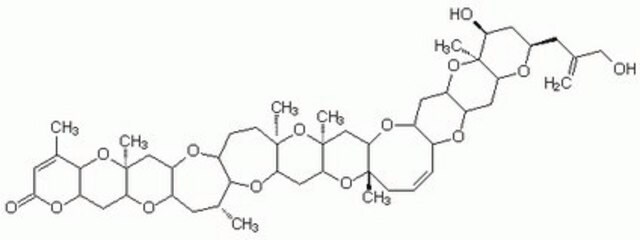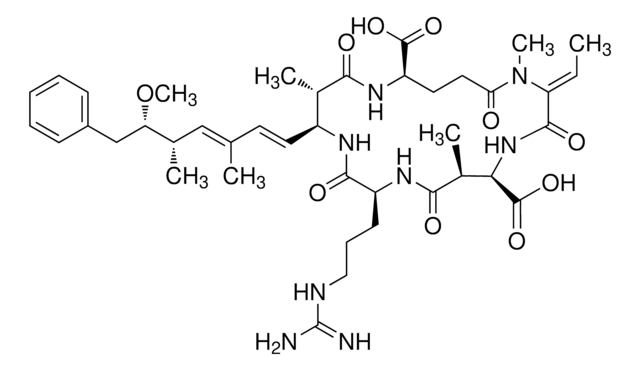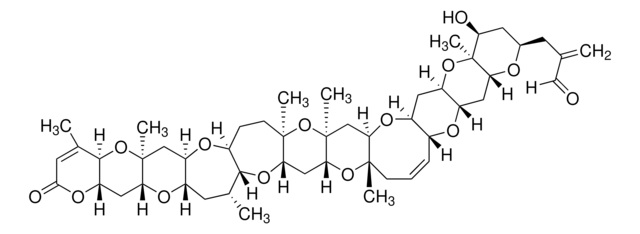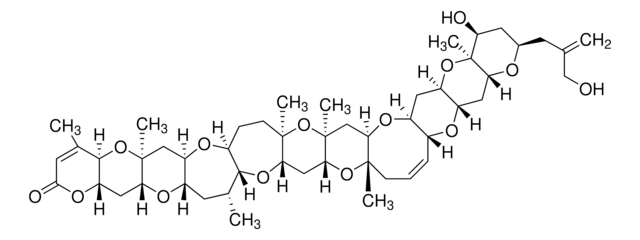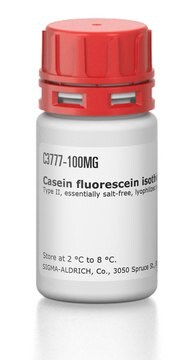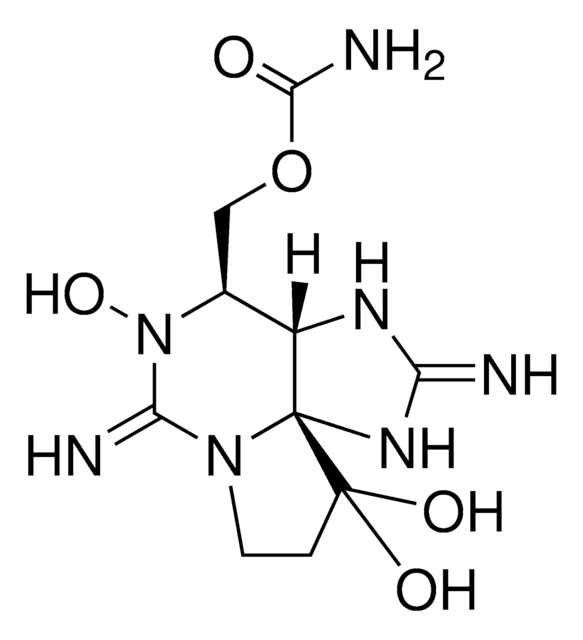203732
Brevetoxin PbTx-2
from Ptychodiscus brevis, ≥95% (HPLC), solid, Na+ channel-binding neurotoxin, Calbiochem®
Sinónimos:
Brevetoxin PbTx-2, Ptychodiscus brevis, Brevetoxin B, GbTx-2
About This Item
Productos recomendados
Nombre del producto
Brevetoxin PbTx-2, Ptychodiscus brevis, Lipid-soluble polyether neurotoxin that binds to Na+ channels on nerves and muscles causing an excessive influx of Na+ across membranes.
Quality Level
assay
≥95% (HPLC)
form
solid
manufacturer/tradename
Calbiochem®
storage condition
OK to freeze
color
tan to white
solubility
ethyl acetate: soluble
methanol: soluble
water: soluble
shipped in
wet ice
storage temp.
−20°C
SMILES string
O1C2(C(OC8(C(OC9C(OC%10C(OC%11(C(OC(CC%11O)CC(=C)C=O)C%10)C)C9)\C=C/C8)C2)C)CC3OC4C(OC5C(OC6C(OC7C(OC(=O)C=C7C)C6)(C5)C)CC4C)CCC31C)C
InChI
1S/C50H70O14/c1-25(24-51)14-28-17-37(52)50(8)41(54-28)19-33-34(61-50)18-32-29(55-33)10-9-12-46(4)42(58-32)23-49(7)40(62-46)21-39-47(5,64-49)13-11-30-44(60-39)26(2)15-31-36(56-30)22-48(6)38(57-31)20-35-45(63-48)27(3)16-43(53)59-35/h9-10,16,24,26,28-42,44-45,52H,1,11-15,17-23H2,2-8H3/b10-9-
InChI key
LYTCVQQGCSNFJU-KTKRTIGZSA-N
General description
Biochem/physiol Actions
Neurotoxin that binds to Na+ channels on nerves and muscles.
Packaging
Warning
Reconstitution
From Catalog:
Solubitlity- removed acetone, EtOAc
Other Notes
Trainer, V.L. 1991. Mol. Pharmacol.40, 988.
Tsai, M.C., and Chen, M.L. 1991. Br. J. Pharmacol.103, 1126.
Trainer, V.L., et al. 1990. ACS Symposium Series418, 166.
Baden, G. 1989. FASEB J.3, 1807.
Baden, D.G., et al. 1988. Toxicon26, 97.
Poli, M.A., et al. 1986. Mol. Pharmacol.30, 129.
Shimizu, Y., et al. 1986. J. Am. Chem. Soc.108, 514.
Nakanishi, K. 1985. Toxicon23, 473.
Baden, D.G., et al. 1982. Toxicon19, 455.
Catterfall, W.A., and Risk, M. 1981. Mol. Pharmacol.19, 345.
Legal Information
signalword
Danger
hcodes
Hazard Classifications
Acute Tox. 2 Dermal - Acute Tox. 2 Inhalation - Acute Tox. 2 Oral
Storage Class
6.1A - Combustible acute toxic Cat. 1 and 2 / very toxic hazardous materials
wgk_germany
WGK 3
flash_point_f
Not applicable
flash_point_c
Not applicable
Certificados de análisis (COA)
Busque Certificados de análisis (COA) introduciendo el número de lote del producto. Los números de lote se encuentran en la etiqueta del producto después de las palabras «Lot» o «Batch»
¿Ya tiene este producto?
Encuentre la documentación para los productos que ha comprado recientemente en la Biblioteca de documentos.
Nuestro equipo de científicos tiene experiencia en todas las áreas de investigación: Ciencias de la vida, Ciencia de los materiales, Síntesis química, Cromatografía, Analítica y muchas otras.
Póngase en contacto con el Servicio técnico